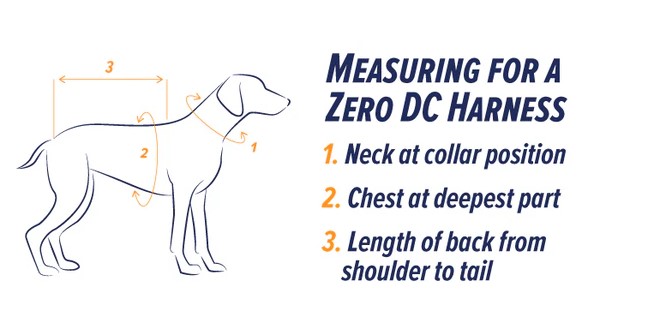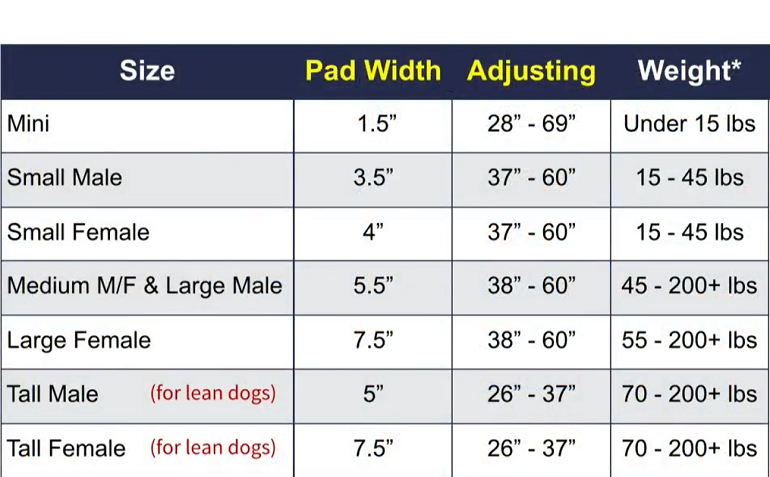Every dog owner wants their furry friend to be comfortable and safe during walks and adventures. A well-fitting harness is crucial for achieving this. Harnesses distribute pressure evenly across the chest and back, preventing strain on the neck and trachea, unlike traditional collars.
Unfortunately, simply knowing your dog’s breed or weight isn’t enough to ensure a perfect fit. Sizing charts can be helpful, but every dog has a unique body shape. To find the perfect harness for your canine companion, taking accurate measurements is essential.
This guide will walk you through the simple process of measuring your dog for a harness in the UK, ensuring a comfortable and secure fit for enjoyable walks and safe outings.
Preparing to Measure
A. Before diving into measurements, gather the necessary tools. You’ll need a flexible tape measure, preferably one designed for sewing or tailoring, as it provides accurate measurements.
B. It’s essential to ensure your dog is calm and relaxed before taking measurements. Engage in some calming activities to help your pup feel at ease, such as gentle petting or offering treats.
Steps to Measure the Dog
Chest Girth:
This is the most crucial measurement for finding the right harness size. The chest girth refers to the widest part of your dog’s torso, typically located just behind the front legs. Here’s how to find it:
- Locate the sweet spot: Imagine your dog standing upright. Run your hand along their side, just behind their front legs, until you feel the widest part of their chest. This is the area you’ll be measuring.
- Wrap it snug, but not suffocating: Hold the measuring tape flat against your dog’s body and gently wrap it around their chest. Ensure the tape measure is snug but not constricting. You should be able to comfortably slip two fingers between the tape and your dog’s body.
Neck Girth:
While chest girth is the primary measurement for harness sizing, some harnesses might also consider neck size. Here’s how to measure your dog’s neck if needed:
- Find the collar zone: Locate the narrowest part of your dog’s neck, where their collar usually sits.
- Snug, but wiggle room: Wrap the tape measure comfortably around your dog’s neck, ensuring it’s not too tight. Similar to the chest measurement, you should be able to fit two fingers between the tape and your dog’s neck.

Image source: bellanpal
Length Measurement:
- Determine the length from the base of your dog’s neck to the base of their tail. This measurement will vary depending on the style of harness you’re considering.
- Use the tape measure to get an accurate length, ensuring it follows the contours of your dog’s body.
- Record the measurement in inches or centimeters.

Image source: dogfit
Comfort and Safety
Comfort First: Benefits of a Dog Harness
Harnesses distribute pressure evenly across your dog’s chest and back, minimizing strain on their neck and preventing coughing or discomfort. This is particularly beneficial for:
- Dogs who pull on the leash: A harness provides better control during walks, preventing your dog from pulling against their neck.
- Brachycephalic breeds: Breeds with short snouts like Pugs, Bulldogs, and Shih Tzus have sensitive airways. Harnesses take pressure off their trachea, allowing them to breathe comfortably during walks.
- Senior dogs or dogs with mobility issues: Harnesses offer more support and stability for older dogs or those recovering from injuries.
- Small puppies: A harness is gentler on a puppy’s delicate neck and trachea compared to a collar.
Beyond these specific situations, harnesses offer a generally more comfortable walking experience for all dogs. The padding on many harnesses prevents chafing, and the secure fit allows for natural movement without restricting your dog’s stride.
Safety Matters: Choosing the Right Harness
Harnesses not only enhance comfort but also provide several safety benefits:
- Escape prevention: A well-fitting harness makes it more difficult for your dog to back out or slip away compared to a collar. This is especially important for escape artists or nervous dogs.
- Better control: Harnesses give you more control during walks, allowing you to guide your dog safely, particularly in crowded areas or near traffic.
- Increased visibility: Many harnesses come with reflective material that improves your dog’s visibility during night walks or low-light conditions.
Choosing the Right Harness:
With so many harnesses available, finding the perfect fit for your dog is crucial. Here are some key factors to consider:
- Size: Measurements are essential! Ensure a snug but comfortable fit around your dog’s chest. Refer to the manufacturer’s size chart and our guide on measuring your dog for a harness (link can be inserted here).
- Style: Different harnesses cater to various needs. For example, a “no-pull” harness can help with leash training, while a padded harness offers extra comfort for longer walks.
- Material: Choose a breathable and lightweight material, especially for warmer climates. Opt for padded harnesses for additional comfort, particularly for dogs with sensitive skin.
- Durability: Ensure the harness is constructed with high-quality materials that can withstand daily wear and tear.
Trying on the Harness
- With the harness selected, it’s time to try it on your dog. Ensure the harness fits snugly but not too tight. You should be able to fit two fingers comfortably under the straps.
- Check for any discomfort or restriction of movement. Your dog should be able to move freely without any rubbing or chafing from the harness.
- If necessary, adjust the straps to achieve a proper fit. Most harnesses feature adjustable straps that allow you to customize the fit to your dog’s unique measurements.
Tips for Dog Harness Sizing
- Don’t rely solely on your dog’s weight and try to guess her harness size based on it. Even small breeds can be surprisingly deep-chested; the Basset Hound is an example. And while a husky Newfoundland and a sleek Great Dane may weigh the same, they’ll probably have different chest measurements.
- Consider weight gain or coat growth if these variables are relevant for your dog. If they are, add two inches to your dog’s girth measurement and shop accordingly—look for a harness that will comfortably adjust to your dog’s smallest and largest girth measurements.
- Choose the larger harness size if your dog’s measurements are in between. Then adjust the harness down for a snug fit.
- There should be no pressure on her throat, and the harness shouldn’t pinch or bind when she walks.
- Look to the harness manufacturer for a product-specific harness fitting guide, because recommended sizes for your dog’s measurements can vary brand to brand or style to style.
Sizing Chart

Image source: worldanimalfoundation
Conclusion
Measuring your dog for a harness may seem daunting at first, but with the right approach, it’s a straightforward process that ensures your furry friend’s comfort and safety. By following these steps, you’ll be well-equipped to select the perfect harness size for your canine companion, allowing you to enjoy walks and adventures together with confidence.
Remember to double-check your measurements and seek assistance from a professional if you’re unsure. With the right harness and a proper fit, you and your dog can embark on countless adventures together, making memories that will last a lifetime.
Frequently Asked Questions (FAQs)
To determine the size of harness your dog needs, measure around their chest just behind their front legs with a soft measuring tape. Use this measurement to find the appropriate harness size according to the manufacturer’s size chart.
When fitting a dog harness in the UK, ensure it fits snugly but not too tight. Adjust the straps to allow room for two fingers to fit comfortably between the harness and your dog’s body. Make sure it doesn’t rub or chafe.
When choosing a dog harness in the UK, consider your dog’s size, breed, and activity level. Look for features like padded chest plates for comfort, reflective strips for visibility, and sturdy buckles for security.
To measure your dog correctly, use a soft measuring tape to measure around their chest just behind their front legs. Take note of this measurement and refer to the manufacturer’s size guide to select the appropriate harness size.
